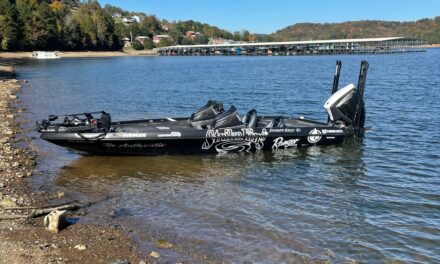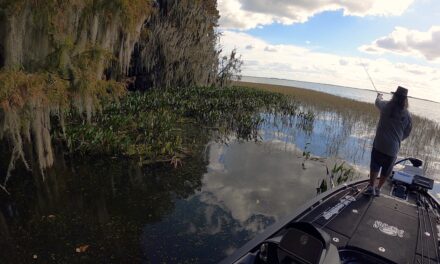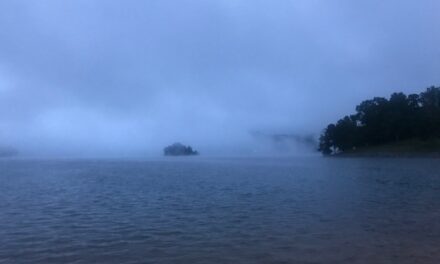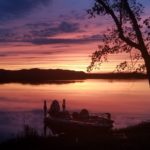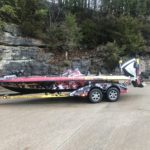Each year, with the end of the spawn, I need to totally repack my boat, which involves a lot of supporting work including switching out a lot of rods, changing line on the reels, switching baits, all in preparation for the dramatic changes that come about in the Post Spawn leading into the summer months.
For me, this is a difficult time, because it leads into an area of fishing where I am admittedly the weakest, and at the same time it is exciting because it facilitates the opportunity to make the most significant advancements in my skill level in continuing preparation for future tournaments. As I have commented in the past, I relocated to Kentucky for the express reason of increasing my proficiency in the TVA lakes, which I believe are essential to being successful on a national level. A clear understanding of post spawn fishing is another hurdle that must be navigated in order to be successful in competitive fishing. This is because many tournaments, both in the middle states, and especially up north take place either during the post spawn period, or during the summer pattern.
Now Largemouth fishing in shallow vegetation and structure aside, which we will discuss at another time, the defining characteristic of post spawn fishing is understanding how to target finicky bass at varying depths. I say varying because it largely depends on the type of lake you are fishing. For example, the term ‘deep’ can mean many things when the context of a particular lake is applied. Deep on a highland reservoir can imply fishing in 30-60 feet of water in a 200 foot deep lake. The same term on a lowland reservoir may mean fishing in 15-30 feet of water. Still the same term taken on a natural lake, or a river based system might only be 8-12 feet. ‘Deep’ simply varies extensively so the idea here is not how deep, but rather deep when compared to the pre-spawn target depth.
On my particular lake, Cumberland in southern Kentucky, the target depth pre spawn is typically between 5-20 feet. This gets particularly reduced when the bass begin to move towards the beds as the spawn gets close. During the spawn, bass bed between 6 and 15 feet, sometimes deeper where the smallmouth are concerned. But now, as the spawn is ending, the water clarity is radically increasing from the early spring 6-18 inches to what will become 4-6 feet and beyond. Being a river fed reservoir, there is very little thermocline to contend with though this does become a factor on the west side in summer, and between light preferences, proximity to baitfish, a lack of shallow structure or vegetation, and the high summer temperatures, the fish are preparing to move into depths that stun most fisherman.
This among so many other reasons, is why I believe Cumberland to be the greatest training lake imaginable. The post spawn here, for many, is the end of good fishing until the fall. To others, it is the signal to shift fishing hours from the daylight period to the famous night fishing common in the southern states.
I do not night fish, ever. Mainly because I believe it to be incredibly dangerous, particularly to my lower unit due to unseen debris in the water, but also because it does not contribute to my readiness to compete. But this places me in a difficult position because I am therefore forced to deal with the fact that bass in this lake are perfectly comfortable at daytime depths of up to 50 feet and beyond. This requires a completely different strategy when compared to early spring and fall. To be prepared for this challenge, there are a number of areas where I heavily focus.
Map preparation, understanding bottom topography
When studying maps, there are really three key areas I am focused on where post spawn is concerned. The first is where the bass spawn actually took place. This is essential because it provides an origin for what will be a journey. The second is where they will be located in the full summer pattern. Finally, all the water in between these two points. This provides me with the ability to establish a course, or path from the origin to the destination. Now realize, there are a lot of other factors to consider such as weather, water temperature, fishing pressure, forage fish spawn and migration patterns, moon phase (yep, I believe in moon phases), current, and the simple fact that bass can do whatever it is they feel like doing and that includes not following my path. (So make no mistake, the anti-pattern is alive and well here, so yes you might well catch them in 2 feet of water at noon when they should be 35 feet deep off a point or suspended on a ledge. They do not care what you think they should do.) But we have to begin somewhere and maps is usually the best choice no matter where your fishing and in what season. Now I say this not to exclude water, but rather to understand possibilities, develop strategies, as well as pivot strategies should your initial ideas fail to result in success.
Now where bottom topography is concerned, I am looking for a few things in particular. The first is summed up by the term ‘irregularities’. This could mean many things, but the usual suspects are always going to be there. Points, humps, sunken houseboats, road beds, the creek/river channel, etc. But these are isolated features. What I am really looking for is these features in the context of the overall path. For example, if I know that both points on the entrance of a creek provide a natural choke point, and the water temperature is approaching 70 degrees, then I prioritize this area as it is likely that shad will be coming in off the main lake to spawn and must pass a relatively narrow area where they can be corralled by bass. Another example is that if I know there will be heavy wind, what kind of current will that create in reference to these features. The same can be applied to blue sky and the depth of the features. There are as many permutations as you can imagine. This is why there is no replacement for ‘time on the water’. But this time is only valuable if you are prepared to fish intelligently. Beating banks without a real idea of what to do does not increase fishing knowledge. In fact, it likely decreases your efficacy because of the disruption in your confidence. Studying topography gives you ideas about ‘this’ particular water on ‘this’ particular day. It provides pieces of the puzzle. Your goal is to take those pieces and form a strategy. If it does not work, form a different strategy. Eventually, I guarantee you will hit the proverbial jackpot. Time on the water translates to trying out enough strategies that you form a conception of what works and doesn’t inside of a myriad of different factors. You have to move from ‘happening upon the right strategy’ to selecting the right strategy based on conditions.
That is key. Because this type of experience can be replicated anywhere you go. Which is the whole point.
Electronics for Verification
While I classify the use of electronic charts and super detailed topographical mapping with the previous section, nothing can provide a fisherman with more piece of mind, or assist in evaluating water faster than the use of electronics to identify the presence of fish.
Now this requires a bit of backtracking. When I was young, I fished out of a rowboat, or a johnboat depending on the year in question, and both models lacked electronics. I was pretty thrilled to have a light, to say nothing of the engine, on my first John boat. At that time, checking the water for fish activity was a manual operation. You would throw out a lure of some kind, typically a Texas rigged worm, and if the fish responded by hitting it, nibbling, or whatever, that was the poor kids version of the red arch we enjoy today. This left so much on the table, but what was I going to do, I could barely afford a second-hand boat let alone the investment in expensive equipment.
Fast forward 30 years. By my estimation, I have at least 15k worth of electronics on my Ranger
It is, without question, a floating supercomputer. Chirp, downscan, side imaging, 3d imaging, livesight, all yapping on a winding ethernet and wireless network for one purpose, to show me whether there are fish under and around the boat. And what do I do half the time, I rig up some lure to test the water for activity. The worm has become a drop-shot and I use it all the time for verification.
The irony is thick.
But make no mistake, if there is nothing on the monitors, I rarely fish a piece of water for long. But nothing replaces the tangible confirmation of dropping a lure down there to make sure, especially if there is topographical evidence that fish might be masked by the structure itself. I can’t tell you how many times nothing has shown on the monitor and yet fish after fish ended up in the live well. Be sure, but be sure with all the information. Electronics are an aide, but they are not the only aide.
The opposite can also apply. Consider the reality that a monitor full of fish may not hold a single bass.
This has happened to me all too often. The one thing I absolutely hate is covering an area for 2 hours only to bring up an 18 inch walleye. Or worse, chasing around suspended fish only to haul in a 3 pound baby striper. I say this because not two days ago this is exactly what happened off a point that I fished mercilessly for 50 minutes. The monitors showed ample fish, but it is difficult to differentiate between 3-5 pound stripers and smallmouth. They look and act the same on the monitors. Sometimes, the visual verification is your only indicator whether you are onto something good, or wasting your time.
So I study the maps and form a strategy, I use my electronics to confirm there are fish in various areas, and I manually confirm, as quickly as possible that they are indeed bass.
But in any case, make no mistake. We live in an electronics fishing world. You cannot viably fish deep structure without good electronics, and a clear understanding of how to interpret the data. If you don’t have them, or you don’t really understand what you are seeing on the monitors, you are greatly disadvantaged.
Variable lure strategies
When I go deep structure fishing, I typically utilize what I call the deep structure summer package. This is important because it related to how I organize my boat, and what equipment I have available. To be honest, I can pack it all if need be and there are times when I have the full load of 30 boxes of tackle, 4 boxes of terminal tackle, deep and shallow water electronics profiles, and 20 rigged rods at the ready. Examples of when I have it all with me include fishing the Mississippi River, pools 7,8 and 9, the James river in Richmond Va, the Potomac, Guntersville, Kentucky Lake, Detroit river, among others.
But there are many times when I have just a few boxes and poles. Here examples include St. Lawrence river (2 boxes and 5 dropshot rods), most Florida lakes (cranks, jigs, plastics), pre-spawn TVA lakes I rarely have anything beyond spinnerbaits, swim baits, swim jigs, and plastics based on water level and clarity.
It changes year to year. But the summer package for me has become very defined and I am beginning to think I have this list down. So lets go over my current deep structure summer package, which is on the boat now.
- Drop Shot Rig, 1000 fish and counting. Here, I use a Lew’s Custom Inshore CI200 spinning reel with a 6’10” custom lite spinning rod. My standard line is 8 lb flourocarbon, I vary the hook size based on the bait and typically use a 1/2 ounce Strike King tour grade tungsten weight. 90% of the time I use a Strike King Ned Ocho in various colors as bait. (This is interesting because I know everyone else uses all kinds of baits, but I catch a ton of really big fish on these little baits, so why change it up.)
- The dreaded Football Jig. I have never really liked the football jig. But I fish it begrudgingly because on certain days, it’s a bag maker. I will tell you this though, If I don’t catch a fish on this rig in the first 15 minutes of using it, I am done and I almost never fish it first, I have to know that there are biting fish in the proximity to break out the football jig. I vastly prefer other options, but like I said, there is a time when it is second to none. Typically I fish this bait on a 7’4″ Lews Custom Pro Speed Stick with a Lew’s Superduty 300 in a 6.5 gear ratio. Any higher ratio and I fish the bait too fast. I typically use 15 lbs fluorocarbon on a reel backed with 30 lbs braid. This gives me a full reel for a good long cast without having to use a ton of line, plus I can go up and down in terms of the flouro without having to re-rig from scratch. I tend to use the 1 oz. Strike King tour grade jig and switch off between the Rage Craw and the Rage Bug depending on how I plan to present. Again, I don’t fundamentally like the football jig because one of my favorite rigs is number 3, and I stand by it.
- The Old School Carolina Rig. If there is any rig that should have baseball walkup music, this is it. The Carolina rig is so dominant that I typically have one on the boat, ready to go, every time I go fishing. There is no rig besides the spinnerbait I have more confidence in throwing. My Carolina setup is rather set in stone. I use a 7’6″ Lews Custom Pro Speed Stick with a Lew’s Pro TI reel in 7.5:1. I know. That is too small a reel to use with a Carolina rig. I have heard it. But that is what I use and here is why. I see the Carolina rig as the ultimate finesse fishing approach. Even more than the drop shot, which I tend to power fish to be honest. When I am drop shooting, I move all over the place, its like a video game on the front of my boat. I rarely take my eyes off the monitors. I can drop shot up and down structure with the best of them. But Carolina rigging for me is a vastly different approach. I don’t tend to cover much water with the Carolina rig. This is very different than what you may have read from other fishermen, but we all fish our own game. For me, the Carolina rig is a targeted approach. If I run over a patch of fish, or I know a school is down deep, like many I will run a drop shot until they stop biting. But after that I tend to creep off to a secluded corner and start working the Carolina rig to full effect. I use the Lew’s Pro TI because my mainline on the Carolina rig rarely exceeds 12 lbs test fluorocarbon, with 10 pound, or even 8 pound mono as the leader line. Most people will use 15-20 pound mainline with 14 pound leaders, but for me this just doesn’t work. Couple reasons, I can cast the 12 pound mainline a mile if I have to. When the water is gin clear, I can vacate the area and cast back into it with a line that is practically invisible and a subtle bait that I can work slowly across the bottom to pick up any unruly bass the drop shot left behind. This is the way I see the Carolina rig. It’s not a rugged approach for me, it is a clever approach. As far as weights go, I use a 3/8 Strike King tungsten bullet weight, and if I am in really deep water, I might jump up to the 1/2 oz. tungsten barrel weight, I always use a red glass bead (superstition), and my bait tends toward the smaller more subtle options. Sometimes the Strike King 4″ super finesse worm is my choice, but I also like the 6″ Strike King Rage Lizard but I fish it so unbearably slow. At that size, its like a trumpet, so there is no reason to make it futile by going too fast. If things get brutal, or the drop shot is shut off, I might even rig up the Ned Ocho. Because it is on mono I get a nice float off the bottom with a light lure. As far as leader length goes, I vary it a lot. Rule of thumb, never shorter than 18″ and never longer than 4 feet. I tend to go longer based on the bite, not the season. If the bite is tough all around, I go longer.
- The Crafty Flutter Spoon. This bait is just not fair. Year after year, I wait on the edge of my seat for the magic flutter spoon day. ‘Pop! Pop! and a bass’ day. Because when the flutter spoon is on, you are going to catch fish, a lot of fish. Nothing is more fun than flutter spooning in deep water. Its a blast and the fish cannot stop hitting it. They know its a lure, they are literally thinking, that’s a lure! Don’t hit it, and then you rip! rip! They blast it every time. Every time I pick up that rod I am so excited that this might be the day, especially if I am in a tournament. My setup is pretty simple. First, I have a ton of optimism. Optimism on tap. I believe that the flutter spoon is the answer to all my fishing problems when the rod is in hand. For equipment I love the Lew’s 7’6″ Heavy Custom Plus SuperGrip. This rod has a huge handle on it, really long even for a heavy duty rod, which is useful because I pop the flutter spoon off the bottom pretty hard and I need leverage in deep water. I typically run 20 pound fluorocarbon on a Lew’s BB1 Pro Speed series reel in 8.1:1. When I hook a fish, chances are the hookup is mediocre at best, even with the extra treble I rig, so I put the fish on an express elevator to the surface. I like the Strike King 5.5″ Chartreuse Shad, but I have used the 4″ from time to time in shallower situations, typically less than 20 feet. Its pretty straightforward from there, they will either hit it or they won’t. If they do, amazing. If not, on to something else, I never waste a lot of time with this lure if it is not apparent they are interested rather immediately.
- The Spinning Swimbait, a middle of the road approach. This is a new one for me in the summer package, but was a staple on the boat during the early spring at a much smaller size. In the summer package, I use the Strike King 1/2 oz. Tour Grade Spin Head with a 4.75″ Rage Swimmer. This is a good sized, heavy swim bait. Now pairing this lure with a Lew’s Pro TI 7’3″ MH rod, and a Pro TI reel rigged with 15 pound fluorocarbon, and you have a setup that will run a swim bait in the middle of a deep water column. If I see fish suspending between 5 and 20 feet deep in 30-40 feet of water, this is my goto solution. I can keep the lure shallow by a shorter cast distance and high sticking the retrieve, and as I lower the rod in a longer cast, it can easily work its way down to 20 feet. This puts the swim bait in front of the fish and gives them the option for a quick meal. Couple of things are required for this plan to work. First, you have to have decent visibility. While the blade does provide a thump and the size moves water, the real effectiveness is in the visual presentation. Secondly, the fish need to be aggressively feeding, or at least active. Best case scenario, the fish are in the process of taking apart a shad ball and you swim your spinner right into the mix. This approach is usually good for a bass or two. But if they are lethargically suspending, this will be a difficult prospect.
- The Appallingly heavy Swimbait. This is a very pronounced, bottom disruption approach. It begins with the 1 oz. Strike King Squadron jig head and a 5.75″ rage swimmer. I couple this with a Lew’s Pro TI 7’4″ Heavy rod and a Lew’s BB1 Pro Speed Spool with a 7.1:1 ratio and 20 pound fluorocarbon. The idea here is to cast this bait as far as possible, let it sink to the bottom and swim it along the bottom, bouncing off rocks, dragging through mud, etc. It is essentially a crankbait approach in water too deep for a crankbait. Deflection is key in this strategy, the more the bait deflects and disrupts the bottom, the greater chance of a reaction strike.
- 10XD Crankbait, because that’s 2x the 5XD. Personally, I love the 5XD, I find it to be the most swimmable crankbait I have ever used. But when I need to get the bait as deep as possible on summer structure, nothing beats the 10XD. I fish the 10XD on a 7’10” Lew’s Custom Plus SuperGrip with heavy power. Again, I go with the BB1 Pro Speed spool with 17 pound Fluorocarbon. Whether I am going for a long cast approach, or long lining, my goal is to get the bait on the bottom and keep it there for as long as possible.
So this is my starting team in the summer package and features a comprehensive approach to deep structure fishing. But that is not to say that I am not keeping some of my spring gear in the boat. I always have at very least a 3/8 oz. KVD finesse spinnerbait, a 3/8 oz. tour grade swim jig, and a Texas rigged KVD perfect plastics Ocho, typically with a 1/4 oz Strike King Tungsten bullet weight. I fish all three on Pro TI rods, usually the 6’10 MH, and Pro TI reels. I carry an additional 5 rods in varying lengths/powers and a bag of reels for unforeseen rigging requirements.
Mental fortitude
Perhaps the most important thing about deep structure fishing is the need for mental toughness. Shallow water and bank fishing provides the angler with a certain level of reassurance because you are casting to tangibly visible locations, you are directly applying strategy that can be seen and felt. Deep structure fishing is very similar to fishing blind. You cannot see what you are casting to, and in many cases, the resulting feedback is difficult to comprehend. This leads to a myriad of psychological barriers that must be overcome.
- Trust. Perhaps the most important aspect of deep structure fishing is that you must trust in many things that are not directly apparent. You have to trust your map assessment and planning. You have to trust your electronics. You have to trust your lure selection. You have to trust your presentation. All of these things must be trusted in order to fish with purpose, and with the skill necessary to capture largely inaccessible fish.
- Patience. Deep structure fishing is not about fish quantity, its about fish quality. There are times when it is necessary to be very patient and endure long periods of inactivity in order to bring in a very large fish. The danger, however, is trying to figure out the difference between patience and futility. This is a ‘time on the water’ issue. As your experience grows, you will begin to recognize the difference between a pointless search and a gainful use of time.
- Being resigned to simplicity. This one took me a long time to understand, and it is connected closely to patience and trust. When I lacked both trust and patience, I believed that there was a secret or some unknown technique that was keeping me from catching fish in deeper water. Eventually, I broke through this barrier with some good days, and realized that you must be resigned to simplicity. Fishing deep structure is like being an actor on the stage. Your job is to present your lines with poise, and let the crowd judge your performance. The crowd being the bass. But while you are presenting your lines, you can have no second thoughts, and don’t overthink the role. Give the drop shot a twitch now and then, drag the bottom rigs, rip the spoon, each lure is relatively simple to operate. Your cast and retrieve should be textbook each time and the results will come.
As we head into Summer, my goal is to cover each one of these lures in depth, but hopefully this primer helped get you ready and thinking about putting together a summer package of your own.
Remember, spring may be ending, but summer offers new and interesting opportunities to catch formidable bass.
Happy fishing!


